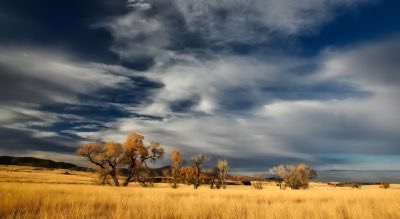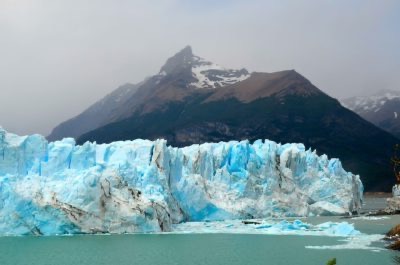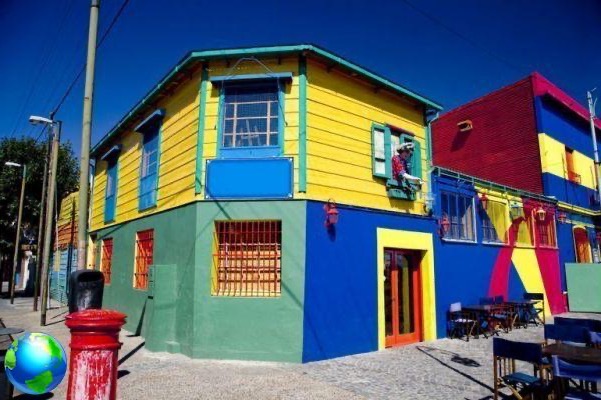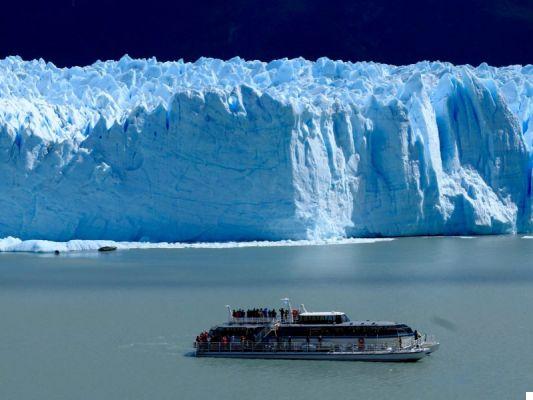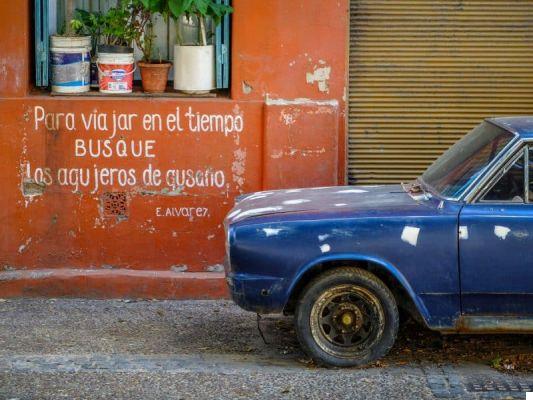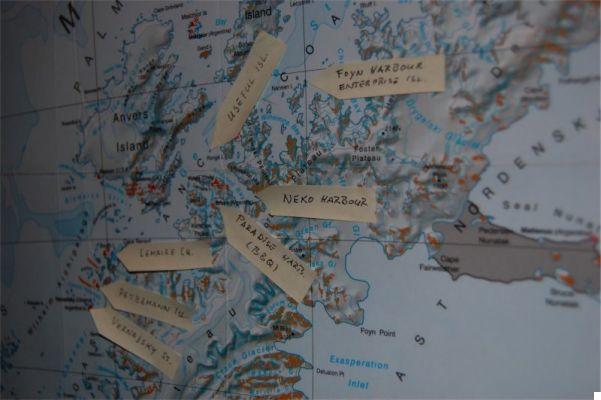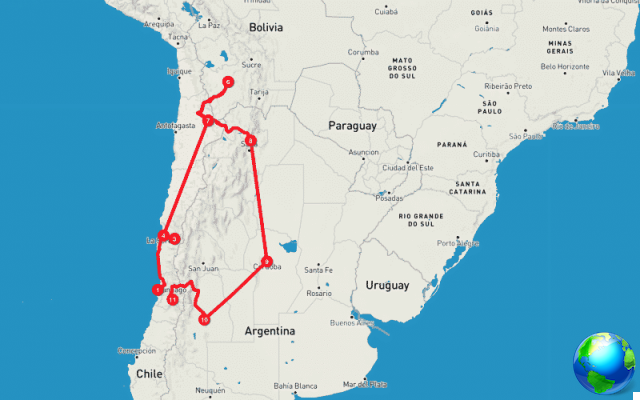La Patagonia is a dream. A trip to Patagonia and Tierra del Fuego it is a journey where nature reigns supreme; we are talking about wild, extreme, uncontaminated lands, mostly uninhabited, and this is precisely what makes them so fascinating. It is a mythical journey in which the footprints left by the great explorers such as Chatwin o Bonatti. In 2017, after years, I finally managed to organize it and took the trip of my dreams, the one that had firmly held the top position on the wish list for at least 10 years now. I have dreamed, studied and planned it so many times that I still find it hard to believe I really did it !! I, a city animal, got lost in these landscapes, I was overwhelmed by the beauty of nature in all its forms, mountains, water, skies, trees, flowers, plants and animals that brought me back to the essence of life.
I will tell you mine trip to Patagonia and Tierra del Fuego with several articles in which I will deepen the different locations with all the practical information (where to sleep, where to eat, etc.), while I will dedicate this first article to more general information on the trip as a whole, to the organization of a DIY Patagonia trip, with the costs, the itinerary, the climate, etc.
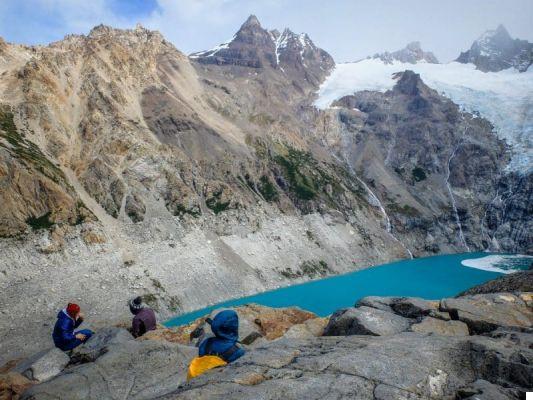
DIY Patagonia trip: general info
The year before I had visited Chile and northern Argentina (to find out more: My trip to South America between Chile, Bolivia and Argentina) and I wanted to close the circle by visiting the south, Patagonia Argentina and the Chilean one, reaching the Tierra del Fuego. To make this trip I decided to start from Santiago de Chile and go down to Ushuaia and then start again from in Buenos Aires. As always I decided I would made this trip mainly by land and so it was: I only took a domestic flight from Ushuaia to Buenos Aires. The rest of the journey I traveled by bus (80%), by car and by ferry. It has been a very tiring journey from a physical point of view (you will have heard me say this phrase often by now); once again I have not been able to keep my curiosity and my desire to explore in check. I bought a round trip flight of about a month but I did the math without the host: to visit everything I visited I would need at least another week! The result of all of this was that I ran like crazy to ride these 4000 Km and I put my body to the test. If you decide to replicate my trip as it is, plan to add at least 7/8 days! In fact, in addition to the tiredness due to constant travel, a trip to Patagonia also means doing trekking and walking nearly every day. If you add the two things together, you understand that the matter becomes quite serious. Specifically, with hindsight I would have added at least one day in Puerto Varas, two days on the island of Chiloè, one day in El Calafate and three days in Torres del Paine.
But let's go back to the organizational aspects of this trip to Patagonia and Tierra del Fuego. Despite being high season (December, January and February correspond to our June, July and August there) I have not booked anything from Spain except the Ushuaia-Buenos Aires domestic flight. I booked the stages as I was there at least a week in advance and it is essential if you take this trip in high season! Buses, hostels and ferries fill up quickly.
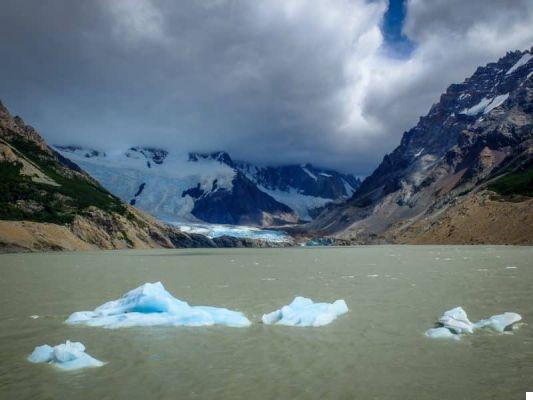
Journey to Patagonia: the itinerary from Santiago to Ushuaia by land (or almost)
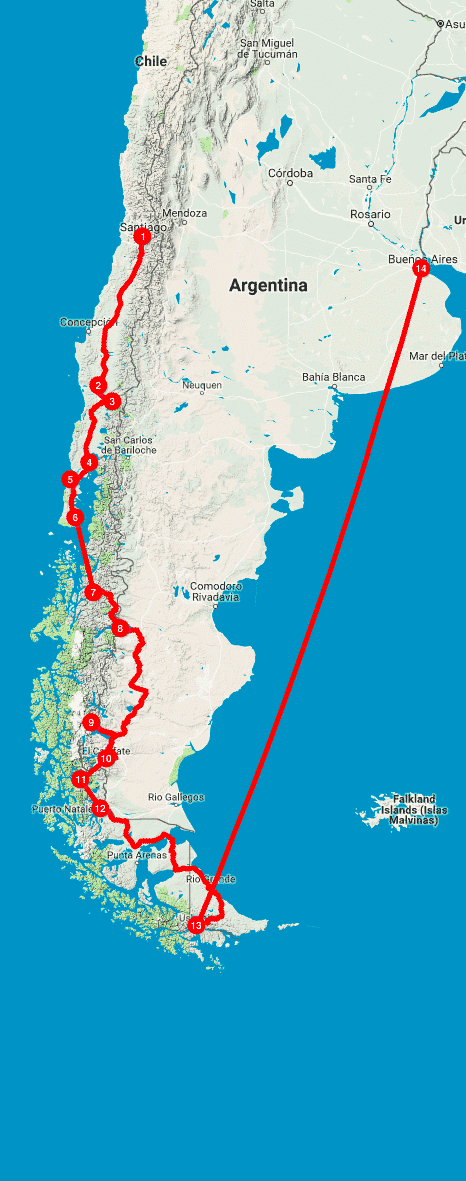
- Departure from Milan (LATAM flight with a stopover in S. Paolo - 607 euros round trip) and arrival in Santiago in the afternoon of the following day
- Day bus Santiago- Temuco (about 9h- 22 euros), rent a car in Temuco and transfer to Caracautin
- Trekking in the Reserva National Malacahuello
- Trekking in the Parque National Conguillio
- Trekking in the Parque National Conguillio + car drop off (165 euros including petrol) and bus to Pucon (2h - 3 euros)
- Trekking in the Parque National Huerquehue
- Relax a Pucon
- Trekking on the Villarica Volcano + bus to Puerto Varas (4h 30'- 14 euros)
- Relax to Puerto Varas
- Bus + ferry to Ancud, on the island of Chiloè (3h30 '- 7 euros) and visit to the pinguinera
- Bus to Castro (1h30 '- 3 euros) and visit of the town + bus to Quellon (1h30' - 3 euros) and board the night ferry Naviera Austral h. 23:00 (25 euros / seat)
- Navigation between the fjords
- Arrival at dawn in Puerto Chacabuco + bus and ferry to Chile Chico (6h - 11 euros) + border crossing in Los Antiguos and night bus to El Chalten (11h - 70 euros)
- Arrival in the morning and relax in El Chalten
- Trekking al Fitz Roy
- Trekking to Cerro Torre + bus transfer to El Calafate (3h - 27 euros)
- Trekking on the Glaciar Perito Moreno (find out more)
- Bus to Puerto Natales (6h - 30 euro)
- Gita to Torres del Paine
- Day bus from Puerto Natales to Ushuaia (12h - 68 euros)
- Visit of Ushuaia
- Visit to Isla Mirtillo (penguins), the lighthouse and the Beagle Strait
- Flight to Buenos Aires (3h30 '- 260 euros)
- in Buenos Aires
- in Buenos Aires
- in Buenos Aires
- return flight to Milan
- I arrive in Milan in the morning
Journey to Patagonia: the costs
All the 28-day trip to Patagonia and Tierra del Fuego (including intercontinental flight to Santiago with return from Buenos Aires) it cost 3150 euros (in 2017). As you may have noticed from the prices of the buses, in the Patagonia Argentina prices are very high, about double that of Chile. In general, everything is very expensive, the excursions, the hostels and the restaurants, especially when you compare them to the prices in Peru or Bolivia. I managed to spend just over 3000 euros always sleeping in the hostel in the dormitory and almost always cooking myself. Only the last week (mainly in Buenos Aires) I indulged in some lunch and dinner at the restaurant. On the other hand, I didn't save on excursions. The most expensive ones were: the climb to the Villarica volcano (100 euros), the trekking on Perito Moreno (160 euros) and the trip to Isla Mirtillo to see the penguins up close (150 euros).
The prices of this article refer to 2017, year in which the Argentine peso was particularly high compared to the Chilean peso. I then returned to Argentina in 2019 and the situation was completely different because the Argentine peso devalued by about 6 times compared to 2016 and everything was much cheaper. Unfortunately in these countries the currency has frightening fluctuations so the cost of the trip can change dramatically between one period / year and another.
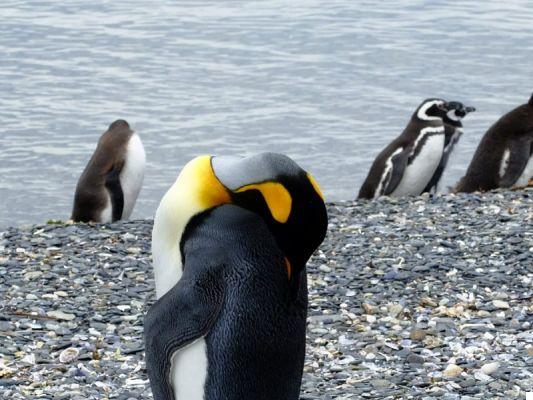
Where to sleep in Patagonia
As for sleeping, I must admit that in Chile I saw the most beautiful hostels in the world! Argentina also has nice and comfortable hostels, but the Chilean ones are truly amazing! All aspects are well cared for, they are beautiful, they have large common areas, clean bathrooms, sockets everywhere, well-equipped kitchens, good wifi, breakfast is often included in the price and, last but not least, they also work as agencies for tour. These are the hostels and facilities where I slept during this Patagonia trip:
- Santiago de Chile: Hotel Luciano K (you can find more in the article on northern Chile)
- Caracautin : Hostal Tu Huella
- pucon : Hostal Chili Kiwi
- Puerto Varas: Margouya Hostel
- Ancud: Hostal 13 Lunas
- Castro: Palafito Hostel
- El Chalten: Accommodation Lo de Guille - Hostel Condor de los Andes
- El Calafate: Hostel Nakel Yenu
- Puerto Natales: The singing lamb
- Ushuaia: Hostel Yakush
- in Buenos Aires: Meridiano Hostel Boutique
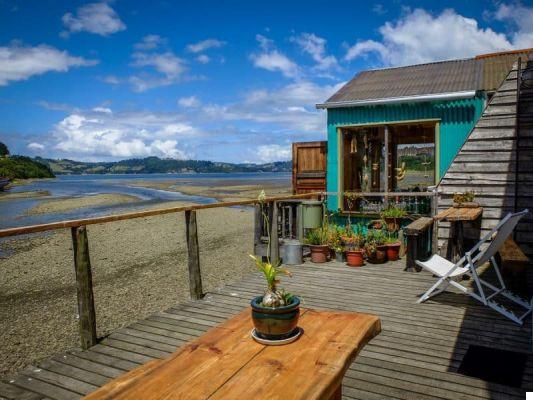
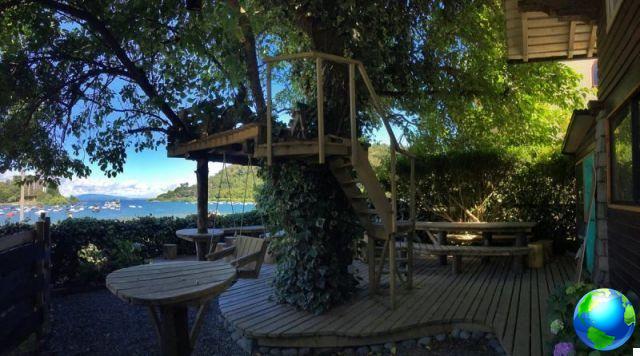
When to go to Patagonia and Tierra del Fuego
Climate-wise, a trip to Patagonia and Tierra del Fuego during our winter means experimenting temperatures ranging from 6-8 degrees up to 30-32 . I started from the summer heat of Santiago (30 degrees but dry, very pleasant I must admit), to then move on to spring / semi-summer temperatures, gradually descending to the Argentine Patagonia. From there I started wearing the windproof shell early in the morning and in the evening to then arrive in Ushuaia, in Tierra del Fuego, with the lowest temperatures of the whole trip (about 6-8 degrees). I finished with a flourish with the hot summer (too much!) Of in Buenos Aires (more than 30 degrees). In general I expected to find colder and more bad weather, especially in southern Patagonia. Fortunately, this was not the case! I had the sun most days and it was also very strong. About this, sun protection in these parts is essential! You can get hot in 5 minutes, especially on glaciers.
One great thing about doing this trip between November / December and January / February is that the days are very long. It is the austral summer and the sun sets very late, in Ushuaia almost at 23pm and you can see many more things with all these hours of light. This trip can actually be done practically all year round, but it is not recommended to do it in the months of June-August. It rains / snows a lot and connections are extremely limited.
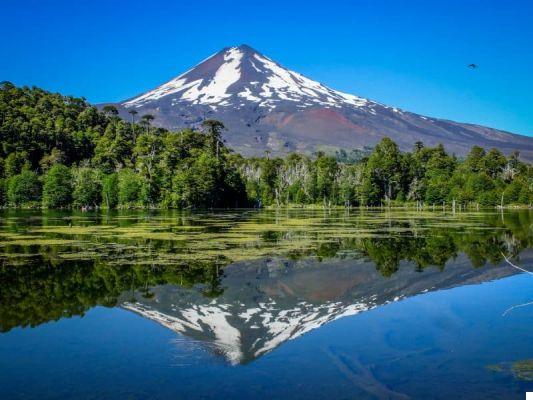
How to get around Patagonia (Argentina and Chilean)
All of South America, therefore also Patagonia, has a really well developed bus network and, in my opinion, the bus remains the best way to get around and to visit like-a-local countries. There are buses of all classes, from basic, super cheap, up to VIP. I tend to always use the medium-high range tourist buses, and I book i "semi-room" seats (with 45 ° reclining seat) oi "bed" (with 90 ° reclining seat, perfect for night journeys). In all tourist buses there is always a bathroom (even the bus makes several stops for the bathroom) and they always provide a snack and a drink; “Cama” trips often include a hot meal and various snacks and drinks. There are many bus companies, but just enter the route you are interested in on Google and you will easily find the website of the company you are interested in with all the timetables. Another site that I find very useful, especially in the planning phase, is the site of Rome2Rio, where there are all the options to get to a certain place. In There are also low-cost airlines in Chile and Argentina (Sky, Jet Smart for example) that cover the whole country, so if you have little time available, consider taking some flights by plane.
How to book buses / ferries / planes
You will soon find that many bus / ferry companies offer the option to buy tickets online, but it is not possible to buy tickets with European credit cards. If you need to book tickets a little in advance you can write an email to the company (in Spanish if possible, you can easily find the contacts from their sites) asking to reserve seats on the bus / ferry you are interested in. You can then pay them directly at the station 24 hours before departure. Considering that (usually) you are staying at least one or two days in one place, it is often sufficient to buy the ticket for the next leg as soon as you arrive at the place of departure. As for domestic flights, especially in Argentina, I recommend that you buy them as early as possible to spend less.
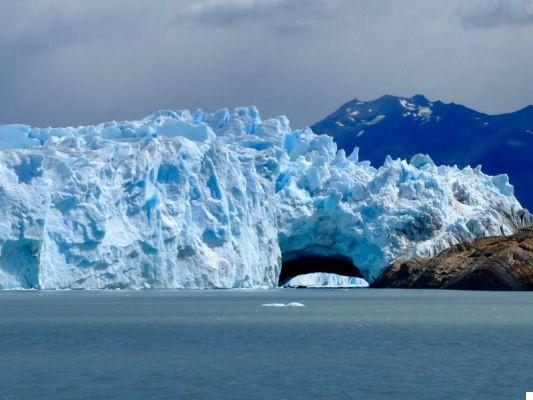
What to do if you have little time to organize your trip
If you have little time to organize your trip to Patagonia and do not want to run into unexpected events, I recommend that you rely on industry experts such as the online travel agency Tuttaltromo (n) do who will help you create a tailor-made travel experience. on your needs. For info consult the Tuttaltromondo website.
Health insurance is required
In Chile and Argentina our health coverage is not valid. My advice is to always take a classic medical-luggage insurance that can cover you during the trip (and against Covid given the current times!). I am very happy with many insurance companies, a site that compares the policies of different companies and proposes the most convenient policy for that particular trip. To do this you will have to enter the data relating to your trip (country, duration, etc.) and they will send you an email with the best proposal that you can then buy directly online (!!!).
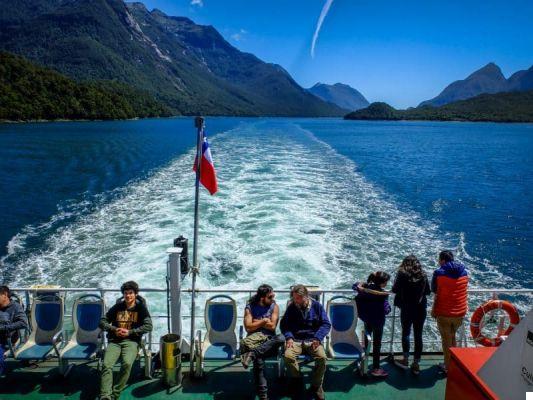
Find all the more specific information about Patagonia in these in-depth articles:
- Southern Chile: the Lakes Region, the island of Chiloé and Torres del Paine
- Trekking on the Perito Moreno
- Ushuaia and Tierra del Fuego, a journey to the end of the world
- What to see in Buenos Aires in 3 days




